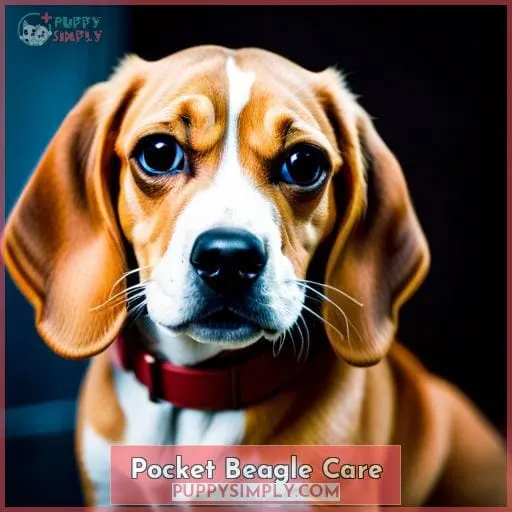This site is supported by our readers. We may earn a commission, at no cost to you, if you purchase through links.
 Uncover the intriguing world of pocket beagles, captivating companions characterized by their petite size, boundless energy, and affectionate nature.
Uncover the intriguing world of pocket beagles, captivating companions characterized by their petite size, boundless energy, and affectionate nature.
These charming dogs, true to their hound heritage, possess an innate curiosity and a keen sense of smell.
Discover the unique traits and captivating personality of the pocket beagle, a breed that promises endless joy and unwavering loyalty.
Table Of Contents
- Key Takeaways
- Pocket Beagle Overview
- Pocket Beagle Characteristics
- Training and Behavioral Traits
- Care and Health Considerations
- Pocket Beagle History
- Choosing a Pocket Beagle
- Pocket Beagle Temperament
- Pocket Beagle Health
- Pocket Beagle Care
- Pocket Beagle Training
- Frequently Asked Questions (FAQs)
- What precautions should I take when introducing a pocket beagle to my home with existing pets?
- How can I effectively train my pocket beagle to minimize barking and howling, especially during separation anxiety?
- Are pocket beagles prone to separation anxiety, and if so, what strategies can I employ to alleviate their distress when left alone?
- What specific health conditions should I watch out for in pocket beagles, and how can I prevent or manage these issues?
- How much exercise does a pocket beagle typically require each day, and what activities are best suited for this breed?
- Conclusion
Key Takeaways
- Petite dogs standing 7-12 inches tall, weighing 7-15 pounds with short, low maintenance coats in hound colors
- Affectionate, people-oriented temperament, though can be stubborn despite intelligence and trainability
- Require daily exercise and mental stimulation to prevent barking and destruction
- Prone to certain health issues like heart disease and epilepsy, needing regular vet checkups
Pocket Beagle Overview
With their short legs and big eyes, pocket beagles are a breed of dog that exudes cuteness and charm.
Their compact size, standing at just 7 to 12 inches tall and weighing between 7 and 15 pounds, makes them highly adaptable to apartment living.
Pocket beagles possess a friendly and affectionate temperament, thriving on human companionship.
They’re generally good with children and other animals, making them excellent family pets.
Despite their small size, pocket beagles have a surprising amount of energy and require daily exercise to stay happy and healthy.
They’re intelligent and eager to please, but can also be stubborn, requiring patient and consistent training.
With proper training and socialization, pocket beagles can make excellent companions for individuals and families alike.
Owning a pocket beagle comes with certain responsibilities, including providing a balanced diet, regular veterinary care, and a safe and loving home.
These charming canines are prone to certain health problems, such as hip dysplasia and eye issues, so regular checkups are essential.
With proper care and attention, pocket beagles can live long and healthy lives, enriching the lives of their owners with unconditional love and companionship.
Pocket Beagle Characteristics
With their petite stature, striking coats, and engaging personalities, Pocket Beagles possess distinctive characteristics.
Their diminutive size, barely topping a foot in height, makes them ideal companions for apartment living.
Their sleek, short coats, available in a vibrant array of hound colors, require minimal grooming, making them low-maintenance companions.
Size
While the Pocket Beagle stands shorter than its standard Beagle cousin, it retains the classic hound build, making it a compact bundle of energy.
This miniature breed, ranging from 7 to 12 inches in height and weighing a mere 7 to 15 pounds, embodies the essence of petite pooches.
Its compact size, coupled with its boundless energy, renders it an ideal companion for those seeking a small dog breed that exudes both charm and athleticism.
Discover the joys of owning a Pocket Beagle, a tiny breed that’s big on personality and perfect for those yearning for liberation and understanding in their canine companion.
Coat Type
Sporting a short, straight coat that’s easy to care for, the Pocket Beagle is a low-maintenance breed.
Its coat requires minimal grooming, with occasional brushing and bathing sufficing to maintain its sleek appearance.
Seasonal shedding is moderate, and regular brushing can help manage loose hair.
The Pocket Beagle’s coat comes in a variety of hound colors, adding to its charm and versatility.
Temperament
What striking characteristics make the Pocket Beagle such a beloved companion?
Their temperament is a symphony of affection, playfulness, and loyalty.
These intelligent and emotionally astute canines thrive on socialization, forming deep bonds with family members, including children.
While their independent streak may occasionally manifest as stubbornness, their inherent desire to please makes them responsive to positive reinforcement training.
Engage them in interactive play sessions to fulfill their exercise needs and stimulate their minds, nurturing a harmonious household where canine communication flows freely.
Training and Behavioral Traits
Your Pocket Beagle’s intelligence makes training easy.
However, stubbornness can emerge.
You’ll enjoy a moderately quiet companion.
Yet, daily exercise is essential to prevent excessive barking and destructive behaviors.
Intelligence
You’ll find the Pocket Beagle to be an intelligent breed, making training a generally smooth process.
Their inherent problem-solving skills make them responsive to positive reinforcement techniques.
To optimize their cognitive development, incorporate enrichment activities like scent games and interactive toys.
Their natural curiosity and eagerness to learn make them excellent candidates for advanced training and obedience classes.
Unleash their full potential by providing ample mental stimulation, and you’ll be rewarded with a devoted, well-behaved companion.
Trainability
With their intelligence and eagerness to please, you’ll find training your Pocket Beagle a rewarding experience.
Employ positive reinforcement techniques to harness their natural desire to learn.
Address behavioral challenges with patience and consistency, understanding the factors that influence their behavior.
Cognitive development flourishes through interactive bonding exercises, strengthening your bond and enhancing trainability.
Early obedience training sets the foundation for a well-behaved companion, making them ideal for first-time dog owners.
Barking
Moving on to barking habits, you’ll find that Pocket Beagles typically aren’t excessive barkers, making them suitable for apartment living.
However, all dogs can bark excessively if not trained properly.
To prevent nuisance barking, it’s crucial to understand the underlying causes, such as separation anxiety, boredom, or attention-seeking behavior.
Effective barking control involves addressing these causes, providing ample exercise and mental stimulation, and implementing positive reinforcement training techniques.
If barking becomes a persistent issue, consulting a professional dog trainer can help you develop a tailored training plan.
Energy Level
Their boundless energy demands daily outlets, ensuring an active lifestyle for you and your lively Pocket Beagle.
Engage in stimulating indoor activities like puzzle feeders and hide-and-seek to combat boredom and separation anxiety, especially if living in a small apartment.
Regular walks, park visits, and engaging games fulfill their exercise needs, while interactive toys and chews prevent destructive behaviors.
Adaptability
Pocket Beagles adapt well to apartment living considering their compact size and moderate energy levels.
But remember, size alone doesn’t guarantee apartment suitability.
They have high energy bursts and require daily exercise.
High-rise living poses challenges due to their wandering nature.
Traveling with them can be tricky, so ensure your lifestyle aligns with their needs.
Care and Health Considerations
Your pocket beagle’s smooth, short coat requires minimal grooming.
Shedding occurs moderately, especially during spring.
You’ll need to provide daily exercise to keep your lively companion healthy.
Regular vet checkups help monitor potential health issues common to the breed.
Grooming
With their short, smooth coat, you’ll find grooming your Pocket Beagle a relatively easy task.
Regular Brushing:
Use a soft brush to remove dead hair and prevent matting.
Bathing:
Bathe your Pocket Beagle every 8-12 weeks using a special shampoo designed for dogs.
Ear Cleaning:
Clean your Pocket Beagle’s ears weekly with a cotton ball and ear cleaning solution.
Shedding
Moving on to shedding, you’ll find that Pocket Beagles have a moderate shedding pattern, with heavier shedding during the spring season.
Regular brushing, perhaps daily, and employing deshedding tools can help keep shedding under control.
Additionally, maintaining a healthy diet rich in omega fatty acids can promote a healthier coat and reduce shedding.
Funny Puppy Syndrome and Beagle Dwarfism can cause excessive shedding, so be aware of these conditions if they arise.
Exercise
Starting now, provide your Pocket Beagle ample daily physical activity to prevent boredom and weight gain, promoting overall well-being.
Prioritize leash training for safe outdoor jaunts, mindful of their innate prey drive.
For indoor activities, engage them with interactive toys and hide-and-seek games.
Health Issues
One should be aware of the health issues that Pocket Beagles may face:
- Heart disease
- Epilepsy
- Eye problems
- Back issues
Genetic health testing can help identify predispositions.
Food allergies and exercise requirements impact their well-being.
Dental care, ear infections, patellar luxation, hip dysplasia, eye disorders like progressive retinal atrophy, and intervertebral disc disease are also concerns.
Regular checkups and preventive care are essential for a long, healthy life.
Lifespan
Since you’ll have your pocket beagle for many years, you’ll be happy to know that their average lifespan is around 12 to 15 years, with regular vet checkups helping to keep them healthy.
However, it’s important to be aware of potential health concerns associated with the breed.
Common ailments include:
- Heart disease
- Epilepsy
- Eye problems
- Back problems
Additionally, some lines may be prone to chondroplasia, a form of dwarfism that can cause warped front legs.
Pocket Beagle History
Explore the fascinating origins of the Pocket Beagle, a smaller version of the standard Beagle.
Tracing its roots back to England, it was used for hunting small animals.
The Pocket Beagle is recognized by organizations like the ACA (American Canine Association Inc.) and DRA (Dog Registry of America, Inc.), highlighting its unique status as a distinct breed.
Origin
Let’s take a trip back in time to explore the intriguing origins of the Pocket Beagle, a story steeped in hunting heritage and human companionship.
These pint-sized hounds emerged from the bloodline of the larger Beagle, tracing their roots to medieval Europe.
Initially employed as ‘glove beagles’ in the 13th century, they gained popularity among noblemen for hunting rabbits and hares. Their compact size made them easy to carry on horseback, and their keen sense of smell proved invaluable in tracking prey.
Over time, the Pocket Beagle’s charm and versatility led to its widespread adoption as a beloved companion dog.
Recognition
While the Pocket Beagle shares a common history with the standard Beagle, it’s only recognized by a handful of kennel clubs, such as the ACA and DRA.
This limited recognition may be due to its relatively small size, which doesn’t conform to the traditional Beagle standard.
Despite this, the Pocket Beagle’s unique characteristics, including its affectionate temperament and adaptability to various living situations, have garnered a devoted following among dog enthusiasts.
Choosing a Pocket Beagle
When selecting a pocket beagle, consider adoption from shelters or rescues.
These organizations may offer these dogs at a lower cost than breeders, typically ranging from $500 to $2,000.
Additionally, ensure that the breeder adheres to breed standards if you intend to show your pocket beagle in competitions.
Adoption
When picking your pocket-sized companion, consider adopting from shelters or rescue organizations.
In these loving environments, you might find your perfect match.
Pocket beagle puppies and adult dogs can be found waiting for a chance to fill your life with joy.
While pocket beagle breeders offer purebred puppies, adoption provides a second chance to deserving dogs, often at a lower cost.
Research pocket beagle colors, temperament, and potential health issues to ensure a harmonious fit with your lifestyle.
Cost
Wondering how much you’ll shell out for a Pocket Beagle?
Several factors influence the cost of ownership:
- Adoption fees: Rescues and shelters typically charge less than breeders.
- Breeder costs: Expect to pay more for a purebred Pocket Beagle from a reputable breeder.
- Life stage expenses: Puppies generally cost more than adult dogs.
- Budget considerations: Factor in ongoing expenses like food, vet care, training, and grooming.
Value for money: Pocket Beagles offer companionship and unconditional love, making them priceless additions to many families.
Pocket Beagle Temperament
Pocket Beagles are renowned for their affectionate and gentle nature, making them excellent companions for families with children and other pets.
Despite their small size, they possess a courageous and curious spirit, exhibiting a remarkable ability to form strong bonds with their owners.
Affectionate
Pocket Beagles’ affectionate nature makes them irresistible companions.
Their unyielding loyalty and devotion will fill your life with unconditional love.
These affectionate pooches adore snuggling, cuddling, and showering their owners with wet kisses.
Prepare to be greeted with enthusiastic tail wags and puppy eyes that convey their deep affection.
Their eagerness to please and unwavering companionship make them exceptional emotional support dogs, providing comfort and joy to families and individuals alike.
Good With Kids
With their gentle nature, you’ll find Pocket Beagles are great around kids, loving to play and cuddle.
Their playful spirit matches children’s energy levels, creating a harmonious bond.
Supervise interactions initially, teaching kids proper handling.
You’ll have a loving companion for your family for the Pocket Beagle’s lifespan of 12-15 years.
Good With Other Animals
In addition to their love for children, Pocket Beagles also get along swimmingly with other animals, making them ideal companions in multi-pet households.
Their friendly and playful nature makes them natural social butterflies, easily winning over the hearts of cats, dogs, and even smaller pets.
With proper socialization, Pocket Beagles can learn to respect and coexist peacefully with other animals, creating a harmonious household.
Their inherent curiosity and eagerness to please make them responsive to training, enabling you to teach them essential obedience commands and good manners around other animals.
Aggressiveness
You’ll rarely encounter aggression in pocket beagles if they’re socialized properly from puppyhood.
Their genetic health and the absence of genetic conditions that predispose them to aggression contribute to their typically friendly nature.
Compared to mixed breeds, pocket beagles generally display lower levels of aggression.
However, any dog, regardless of breed, can exhibit aggression if exposed to specific triggers like fear, pain, or resource guarding.
Understanding these triggers and providing proper training can help prevent aggressive behavior in your pocket beagle.
Pocket Beagle Health
Now, let’s delve into the health aspects of these captivating companions.
Pocket beagles have soared in popularity due to their remarkable adaptability, making them exceptional emotional support dogs, therapy dogs, and companions in diverse climates. With an average lifespan of 12 to 15 years, they offer years of unwavering loyalty and companionship.
Resilient and Adaptable:
- Pocket beagles possess an innate resilience, thriving in various climates and living conditions.
-
Their adaptability makes them suitable for both rural and urban environments, offering unwavering companionship wherever life takes you.
Minimal Grooming Needs:
- These low-maintenance pooches require minimal grooming, making them ideal for busy individuals.
-
Their short, smooth coats demand occasional brushing to maintain their sleek appearance and radiant health.
Prone to Certain Health Issues:
- While generally healthy, pocket beagles may encounter specific health concerns.
- Regular veterinary checkups and a balanced diet are crucial for preventing and managing potential issues, ensuring your furry friend remains happy and healthy throughout their life.
Pocket Beagle Care
To provide the best care for your Pocket Beagle, follow this comprehensive guide covering daily exercise, proper nutrition, and regular grooming.
Ensure your Pocket Beagle receives ample exercise to prevent obesity and destructive behaviors. Engage in daily walks, runs, or games of fetch to fulfill their energetic nature. To prevent wandering risks and noise complaints in apartment living, provide interactive toys and mental stimulation indoors.
Feed a high-quality diet tailored to their age, size, and activity level, avoiding overfeeding to maintain a healthy weight.
Regular grooming, including brushing and nail trimming, keeps their coat healthy and minimizes shedding.
Stay vigilant for signs of common health issues in small dogs, such as joint problems, dental disease, and respiratory issues. Genetic health testing can identify predispositions to certain conditions, allowing for preventive measures.
With proper care, your Pocket Beagle can enjoy a long, healthy, and happy life by your side.
Pocket Beagle Training
With their keen intellect and eagerness to please, training your Pocket Beagle can be a rewarding experience that strengthens your bond.
Positive reinforcement is key, as these intelligent creatures respond well to rewards and praise. Start with basic obedience commands like sit, stay, and come, using treats or toys as incentives. Crate training is also beneficial, providing a safe space and preventing destructive behaviors when you’re away.
Establish an exercise routine that fulfills their energetic nature, preventing boredom and destructive behaviors. Daily walks, playtime in the park, or interactive games can channel their energy positively.
Socialization is crucial for well-rounded behavior; expose your Pocket Beagle to various people, animals, and environments to prevent anxiety and aggression.
Address chewing behaviors early on by providing appropriate chew toys and discouraging chewing on furniture or personal belongings.
Consistency and patience are vital in training your Pocket Beagle. With the right approach, you’ll have a well-behaved companion who brings joy and fulfillment to your life.
Frequently Asked Questions (FAQs)
What precautions should I take when introducing a pocket beagle to my home with existing pets?
To ensure harmony in your multi-pet household, introduce your pocket beagle gradually.
Supervise initial interactions, providing ample space and breaks to avoid overwhelming your existing pets.
Patience and positive reinforcement will foster a peaceful coexistence.
How can I effectively train my pocket beagle to minimize barking and howling, especially during separation anxiety?
Carefully teach them quiet using positive reinforcement.
Provide stable routines, sufficient exercise, and mental stimulation.
Offer safe chew toys for separation.
Positively reinforce calm behavior before departing.
Managing separation distress takes patience and creativity.
Are pocket beagles prone to separation anxiety, and if so, what strategies can I employ to alleviate their distress when left alone?
Unfortunately, pocket beagles may experience separation anxiety when left alone.
Try providing stimulating toys, keeping a regular routine, and avoiding making departures overly emotional.
Additionally, crate training with positive reinforcement can establish a secure space.
Remaining calm and unfazed yourself also helps them adjust.
Reaching out to an experienced trainer or veterinarian can provide more tailored guidance.
What specific health conditions should I watch out for in pocket beagles, and how can I prevent or manage these issues?
Focus on potential health issues:
- Hip dysplasia
- Eye problems
- Patellar luxation
- Heart disease
Have regular vet checkups, provide proper nutrition and exercise, avoid obesity, and monitor for any emerging conditions.
Early detection and proactive care are key to managing health in pocket beagles.
How much exercise does a pocket beagle typically require each day, and what activities are best suited for this breed?
Aim for 30-60 minutes of vigorous exercise daily.
Activities like brisk walking, playing fetch, or following scents on leashed trails can help achieve this goal.
Since they have high stamina, provide both mental and physical stimulation.
Prioritize on-leash excursions or securely fenced areas to prevent wandering.
Conclusion
Indeed, the pocket beagle’s charm extends beyond its compact size, captivating both families and individuals with its endearing personality and unwavering loyalty.
As a proud owner of this exceptional breed, you’ll relish every moment spent with your pocket beagle, creating cherished memories and forging an unbreakable bond.
















